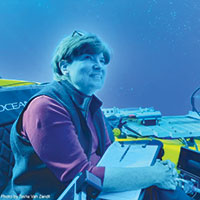 ORCA founder’s story wins ‘wave’ reviews at film fest
ORCA founder’s story wins ‘wave’ reviews at film fest
STORY BY STEVEN M. THOMAS (Week of September 11, 2025)
Photo: Marine biologist Edie Widder. Photo by Tasha Van Zandt
Vero Beach’s most notable marine biologist Edie Widder officially joined the rarified ranks of celebrity scientists this month when a full-length documentary about her life and work premiered at the Toronto International Film Festival.
“They treated us like superstars,” Widder says of the whirlwind four days she spent in Toronto with award-winning documentarian Tasha Van Zandt, giving talks and interviews and smiling into the bright flash of cameras.
One of the top film festivals in the world, TIFF attracts half a million filmgoers and was flush with scores of A-list stars.
Widder said the film festival experience “was very fun and incredibly gratifying.”
The film, which culminates with the first ever footage of what Widder calls the flashback phenomena – a dazzling occurrence in which the underwater world lights up like the sky on the 4th of July – is “not simply a glorious journey to the depths of the ocean, [but also] ... a finely realized portrait of Dr. Edith Widder, a pioneer in the study of bioluminescence,” according to film journal Point of View Magazine.
“I felt like Edie should be just as well known as Jacques Cousteau [and] David Attenborough,” Van Zandt told POV in a joint interview with Widder at the festival.
Widder’s scientific career began in the late 1970s at UC Santa Barbara, where she earned her Ph.D. in neurobiology, and was focused from the start on bioluminescence. She came to Harbor Branch Oceanographic Institute in Fort Pierce in 1989, in part to make use of the Johnson Sea Link submersibles for which Harbor Branch was known to deepen her undersea exploration.
In 2005, she left Harbor Branch to found ORCA, the Ocean Research and Conservation Association, to research and try to reverse the decline of the Indian River Lagoon, setting up her headquarters in the old Coast Guard station on the south side of the Fort Pierce Inlet.
By 2006 her accomplishments unraveling the mysteries of bioluminescence and inventing important scientific instruments to advance ocean research were notable enough to catch the attention of the MacArthur Foundation, which awarded her a coveted MacArthur Fellowship, also called a genius award.
After being well known in the marine science community for decades, Widder broke through to wider recognition in 2012, when she used an instrument she invented that mimics bioluminescence to lure in and get video of the giant squid for the first time ever.
The giant squid headlines caught Van Zandt’s eye.
“I followed that story when it came out and was just fascinated,” she told Point of View Magazine. “It showed me how little we’ve explored and discovered about our own planet and how many mind-blowingly amazing, humbling discoveries there are to be made.
“Ever since I was a kid, I have been a huge fan and admirer of our deep-sea world, starting with 20,000 Leagues Under the Sea by Jules Verne. [Then] I learned about this amazing woman, Edie, who got the first footage of the giant squid live in its natural habitat ... and realized her story had not been told.”
The backbone of Van Zandt’s hour-and-a-half film is a face-to-face interview with Widder, which is illustrated by archival footage from Widder’s many ocean expeditions and deep-sea dives and scenes from her latest voyage to the Azores.
Widder has spent her life trying to understand the oceans and reverse the degradation of the marine environment, and she hopes “A Life Illuminated” will further that life and death cause.
Primarily a scientist, Widder says she has had to become a story-teller, too, to share what she has seen and discovered with the world in hopes of inspiring others to overcome environmental doom and gloom and join in the effort to explore the natural world and find ways to co-exist with nature.
“I’ve spent a lot of my career trying to get people to tap into our instincts as explorers,” she says. “We don’t understand our life support system, this planet, these oceans, and exploration is how we learn about the world and learn how to live in successfully. A big part of what the film is about is showing people as explorers.”
“When I tell stories, I tend to go off on the science, but this film tells the story in a different way, appealing on a heartstring level. The film is very special.”
In an interview with Vero Beach 32963, Widder said she plans to return to her work at ORCA, which moved to Vero Beach in 2022 and opened a new headquarters here last year at 1235 16th St., between the railroad tracks and Old Dixie Highway.
With 20 staff members – including 10 research scientists and engineers – and hundreds of citizen scientist volunteers, ORCA is the primary instrument Widder has in her toolbox to try and restore the health of the Indian River Lagoon and, by extension, the ocean beyond the barrier island.
She hopes to develop new, better sensors and extend ORCA’s Kilroy network, which tracks pollution and other air and water conditions up and down the lagoon, and continue to inspire others to join the exploration of nature.
“It is all about making those connections, between people and the natural world,” she says.



